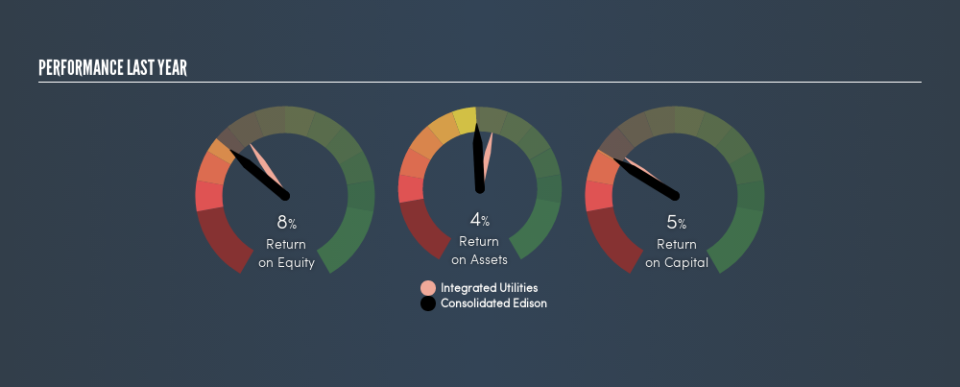Is There More To Consolidated Edison, Inc. (NYSE:ED) Than Its 5.0% Returns On Capital?

Today we'll evaluate Consolidated Edison, Inc. (NYSE:ED) to determine whether it could have potential as an investment idea. To be precise, we'll consider its Return On Capital Employed (ROCE), as that will inform our view of the quality of the business.
First, we'll go over how we calculate ROCE. Then we'll compare its ROCE to similar companies. Then we'll determine how its current liabilities are affecting its ROCE.
Return On Capital Employed (ROCE): What is it?
ROCE is a measure of a company's yearly pre-tax profit (its return), relative to the capital employed in the business. All else being equal, a better business will have a higher ROCE. In brief, it is a useful tool, but it is not without drawbacks. Author Edwin Whiting says to be careful when comparing the ROCE of different businesses, since 'No two businesses are exactly alike.'
How Do You Calculate Return On Capital Employed?
The formula for calculating the return on capital employed is:
Return on Capital Employed = Earnings Before Interest and Tax (EBIT) ÷ (Total Assets - Current Liabilities)
Or for Consolidated Edison:
0.05 = US$2.4b ÷ (US$55b - US$6.3b) (Based on the trailing twelve months to March 2019.)
So, Consolidated Edison has an ROCE of 5.0%.
Want to participate in a short research study? Help shape the future of investing tools and you could win a $250 gift card!
Check out our latest analysis for Consolidated Edison
Is Consolidated Edison's ROCE Good?
ROCE is commonly used for comparing the performance of similar businesses. Using our data, Consolidated Edison's ROCE appears to be around the 5.2% average of the Integrated Utilities industry. Putting aside Consolidated Edison's performance relative to its industry, its ROCE in absolute terms is poor - considering the risk of owning stocks compared to government bonds. It is likely that there are more attractive prospects out there.
When considering this metric, keep in mind that it is backwards looking, and not necessarily predictive. Companies in cyclical industries can be difficult to understand using ROCE, as returns typically look high during boom times, and low during busts. ROCE is, after all, simply a snap shot of a single year. Since the future is so important for investors, you should check out our free report on analyst forecasts for Consolidated Edison.
What Are Current Liabilities, And How Do They Affect Consolidated Edison's ROCE?
Current liabilities are short term bills and invoices that need to be paid in 12 months or less. Due to the way the ROCE equation works, having large bills due in the near term can make it look as though a company has less capital employed, and thus a higher ROCE than usual. To counteract this, we check if a company has high current liabilities, relative to its total assets.
Consolidated Edison has total assets of US$55b and current liabilities of US$6.3b. Therefore its current liabilities are equivalent to approximately 12% of its total assets. This is a modest level of current liabilities, which will have a limited impact on the ROCE.
Our Take On Consolidated Edison's ROCE
Consolidated Edison has a poor ROCE, and there may be better investment prospects out there. You might be able to find a better investment than Consolidated Edison. If you want a selection of possible winners, check out this free list of interesting companies that trade on a P/E below 20 (but have proven they can grow earnings).
If you are like me, then you will not want to miss this free list of growing companies that insiders are buying.
We aim to bring you long-term focused research analysis driven by fundamental data. Note that our analysis may not factor in the latest price-sensitive company announcements or qualitative material.
If you spot an error that warrants correction, please contact the editor at editorial-team@simplywallst.com. This article by Simply Wall St is general in nature. It does not constitute a recommendation to buy or sell any stock, and does not take account of your objectives, or your financial situation. Simply Wall St has no position in the stocks mentioned. Thank you for reading.

 Yahoo Finance
Yahoo Finance 
